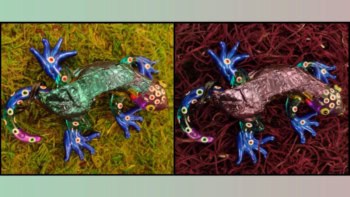
A new metasurface laser can produce light in any desired angular momentum state, including highly chiral or “twisted” light capable of manipulating physical objects. According to its developers at the University of the Witwatersrand (Wits) in South Africa and Harvard University in the US, this tunable, high-angular momentum light source could also be used to encode information in optical communications.
The angular momentum of light is the sum of two independent components: spin angular momentum (SAM) and orbital angular momentum (OAM). SAM is associated with circularly polarized light and arises when the electric and magnetic field vectors of light rotate over the course of a wavelength. Because SAM can have only two values – right or left circular polarization – its applications are relatively limited. OAM, on the other hand, results from the rotation of a light wave’s phase, and can take on any value. This variability makes OAM useful for a wider range of applications, including “optical spanners” – devices that trap and rotate tiny particles using light – and transferring data through optical fibres without crosstalk (multiplexing), to name but two examples.
Challenges of producing OAM states
The flexible nature of OAM means that a beam of light can, in principle, carry an unlimited amount of angular momentum. In practice, however, dialling up a desired OAM state is far from easy, explains study co-leader Andrew Forbes from Wits’ School of Physics. While various techniques exist, their efficiency – the proportion of light converted into the desired state – is limited. Alternatively, a device known as a q-plate can transform SAM into OAM with up to 100% efficiency, but it only works with pure right or left circularly polarized light. Because real light beams often have intermediate (elliptical) polarization, this is a significant drawback, since adding a fixed amount of OAM to one spin state and an equal and opposite amount to the other produces a net angular momentum of zero.
New forms of chiral light and the highest AM
The new device overcomes these obstacles by incorporating a metasurface – an artificially engineered nanostructure that interacts with light in unusual ways – into the laser cavity. The design of this metasurface builds on the Harvard group’s previous work and consists of rectangular amorphous pillars of TiO2 just 600 nm high. These nanopillars are separated by distances shorter than the wavelength of light being modulated, and they act like optical antennas – introducing spatially varying phase delays in the light rays that pass through them and moulding the light beam according to the desired profile. “In our experiment, we pass light through the metasurface many times, giving it a new twist in its phase each time we do so, while controlling the polarization of the light at the same time,” Forbes explains.
The result is a device that produces two output beams with OAM values that differ by as much as 90 units, resulting in a large non-zero total angular momentum. According to Forbes, this is the first laser that can produce such highly chiral light in any desired angular momentum state. “One of our demonstrations was a laser beam with OAMs of 10 and 100 in the same beam (with horizontal and vertical polarizations respectively),” he tells Physics World. “The prior record was just +10 and -10 (and therefore zero total AM).”
According to Federico Capasso, the study’s other co-leader and a professor of applied physics at Harvard, the use of metasurfaces was “the determining factor” in achieving a record-high optical angular momentum, L, of 100. “Alternative technologies such as q-plates and spatial light modulators (SLMs) have not even come close to these values of L,” he says. “What is more, the design limitations and fabrication constraints of those technologies can’t give the arbitrary wavefront control provided by metasurfaces, of which the non-symmetric vector vortex beams described in this paper are an outstanding example.”
Dramatically reducing light losses
According to Harvard’s Yao-Wei Huang, who constructed the metasurface used in the laser, the new design “demonstrates the highly effective coupling between arbitrary spin (a linearly, circularly, or any elliptically polarized state) and orbit (symmetric or non-symmetric helicity) of light in a compact planar structure”. Forbes adds that the device can couple non-symmetric OAM to linearly polarized states, rather than being limited to symmetric OAM and circularly polarized states, as q-plates are. “This may seem like a minor technical detail, but it means we can halve the number of elements inside the laser, so dramatically reducing light losses and allowing us to reach OAM values of 100 (a x10 advance over the prior state-of-the-art from such lasers),” he explains.

Laser combo opens up futuristic terahertz technology
According to Forbes, another interesting feature is that the beams carrying 10 and 100 units of angular momentum are significantly different in size when they come out of the laser. When they travel around the cavity, however, they converge to a similar shape and size, where they experience optical gain. This allows for a coherent mode – a tell-tale sign of lasing – even though the actual beams appear spatially separated.
“We can use this type of light to optically drive gears in situations where physical mechanical systems would not work, such as in microfluidic systems to drive flow,” he explains. “Such systems could be used to make miniature lab-on-a-chip devices in which medicine would be performed on a single chip rather than in large experimental apparatus in the lab.”
The laser, which is described in Nature Photonics, could also be made bigger by increasing the size of the metasurface and the gain volume to produce a high-power bulk device. “In both these cases, the lasing mode wouldn’t require any intra-cavity elements other than the metasurface itself,” Forbes says.



